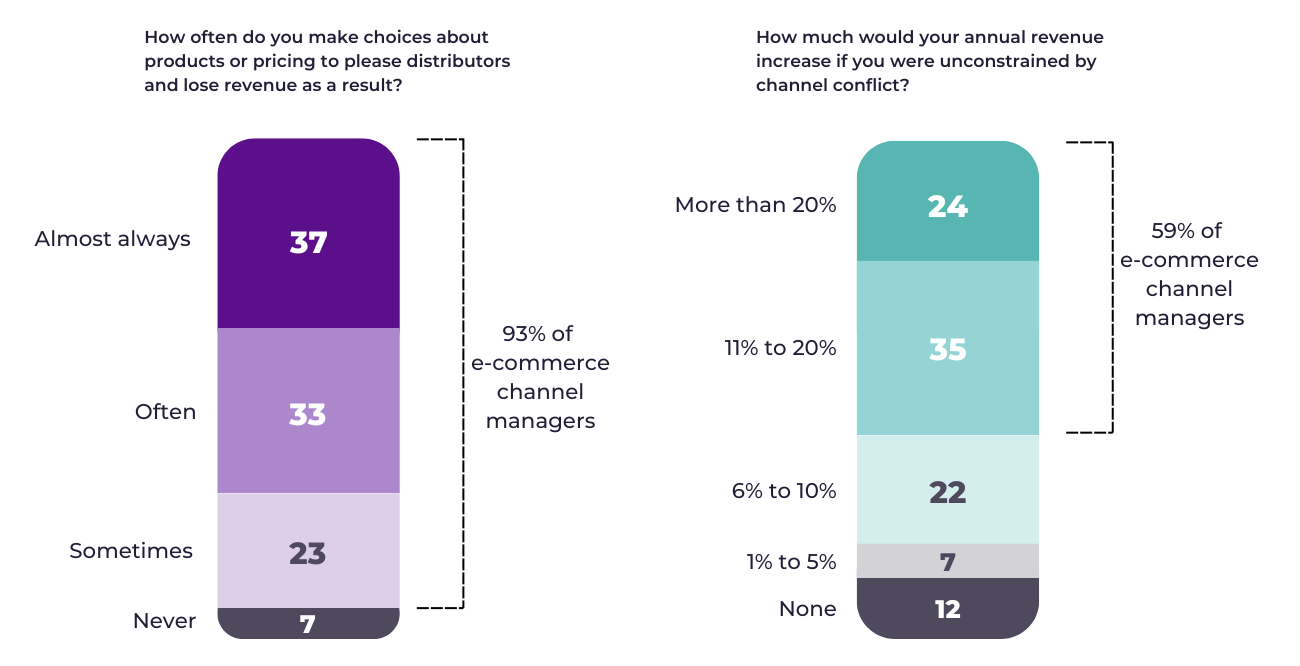Overcoming channel conflicts created by resellers
Channel conflicts are a constant challenge for brands and manufacturers as they can have a significant impact on brand perception, sales and customer satisfaction.
These conflicts are common whether a company sells cleaning products, dairy products, car parts or pyjamas. As e-commerce has taken a larger share of total sales in both B2C and B2B, companies have had to evaluate the new sales opportunities these channels represent. But also the friction that e-retailing can create with existing channels.
And this has been no easy task. In a BCG Digital Ventures survey of 600 e-commerce channel managers, 38% responded that channel conflict is their number one concern, and 44% believe that channel tension will continue to grow in the future.
Channel conflict may sound harmless, but the effect it has on sales can be considerable. 93% of those surveyed by BCG said that product assortment or pricing decisions made to please retailers had cost them some of their profits. In addition, two-thirds said they avoided selling through certain channels to avoid disrupting existing sales in other channels.

Source: BCG Channel Manager Survey, 2021
What are the main channel conflicts created by resellers?
In this post we want to address some of the most common problems that arise with resellers:
Parallel selling
Parallel selling occurs when resellers sell products through channels that are not authorised by the manufacturer. This can lead to a number of problems, including the erosion of the exclusivity of certain resellers and confusion among consumers about where to buy authentic products. Parallel selling can also lead to price discrepancies, which can negatively affect the perception of brand value.
This phenomenon is intensified when resellers purchase products at lower prices in different markets and sell them in more expensive ones. This practice not only undermines agreements with official distributors, but can also violate the manufacturer’s warranty and service policies, creating a cycle of distrust between consumers and the brand.
Fierce competition and other unfair practices
Competitiveness among resellers can lead to price wars. When several compete for the same group of customers, it is common for them to cut prices to gain market share. While this may benefit consumers in the short term, in the long term it can devalue the brand and reduce profit margins for all involved, including the resellers themselves.
In addition, fierce competition can lead to unfair business practices, such as defamation of other resellers or the use of aggressive marketing tactics. These practices not only damage relationships between resellers, but can also damage the reputation of the brand globally.
The challenge for sellers on marketplaces
Marketplaces, such as Amazon, eBay and others, offer resellers an easy and accessible platform to reach a wide audience. However, this also presents a number of challenges. Marketplaces often have a large number of sellers offering the same products, which can lead to strong price competition and a lack of control over how products are presented.
An additional problem is authenticity. In many marketplaces, counterfeit products are a real concern. Consumers may not be able to distinguish between a legitimate reseller and one selling counterfeit products, which can negatively affect brand trust. In addition, marketplaces’ return and customer service policies may differ from the manufacturer’s official policies, causing confusion and potential customer dissatisfaction.
Amazon Vendor and the monitoring of pricing changes
Amazon Vendor is a programme where Amazon buys products directly from manufacturers and then sells them to consumers through its platform. While this can provide great visibility and market access, it can also cause significant pricing problems. Amazon has the ability to reduce product prices to remain competitive, which can destabilise the market and create tensions with other resellers who cannot compete with those prices.
In order to be able to reduce the prices at which it sells its products, Amazon monitors the prices of other sellers on the platform, and thus manages to anticipate and set more competitive prices.
Changes in pricing by Amazon may lead to a misperception of the value of products, as consumers become accustomed to lower prices that are not sustainable in the long term for other resellers. In addition, this can lead to additional pressure on profit margins, affecting both resellers and manufacturers.

How to resolve these conflicts
A well-conceived strategy for expanding sales channels in the online environment and collaborating with resellers of your products can mitigate potential conflicts.
The following actions can help you establish such a strategy and resolve channel conflicts:
1. Establish clear channel policies
It is essential that brands clearly define and communicate their channel policies. This includes distribution agreements, sales restrictions and minimum advertised prices (MAP). Resellers need to understand the expectations and consequences of not complying with these policies.
2. Monitoring and compliance
Brands should invest in tools and resources to monitor reseller activity. This can include price surveillance, verification of product authenticity and identification of unauthorised sales. Corrective actions must be swift and consistent to maintain the integrity of the channel.
3. Collaboration with marketplaces
Work directly with marketplaces to ensure that products are accurately presented and that pricing and return policies align with those of the brand. This may include enrolling in authenticity programmes (such as Amazon Project Zero) or exclusive partnerships.
4. Consistent pricing strategies
Maintaining a consistent pricing strategy across all channels is crucial. Brands should consider implementing minimum advertised price (MAP) programmes to avoid price wars and ensure healthy profit margins for all resellers.
5. Reseller education and support
Provide resellers with the information and support necessary for them to understand the importance of following brand policies. This may include training, access to marketing materials and a direct communication channel to address questions and concerns.
6. Control inventory
Limiting the availability of products through unauthorised channels can help reduce parallel selling. Brands should be strategic about how and where they distribute their stock to maintain control over its distribution.
Effective strategies for managing reseller-created channel conflicts
Channel conflicts created by resellers are a complex challenge that requires a multi-faceted approach.
For example, one of the strategies that can be effective in managing these conflicts is to use a tool that integrates marketplace and sellers monitoring with price monitoring, such as flipflow. With this tool, you can check the prices of competitors on different marketplaces and thus anticipate and adjust your prices to be as competitive as possible. This is the same strategy that Amazon uses through its Amazon Vendor programme.
By implementing all the strategies discussed in the previous section, brands will be able to mitigate channel conflicts and maintain integrity in their distribution.
Ultimately, the key is communication and cooperation between all stakeholders to ensure a positive experience for consumers, distributors and resellers alike.



